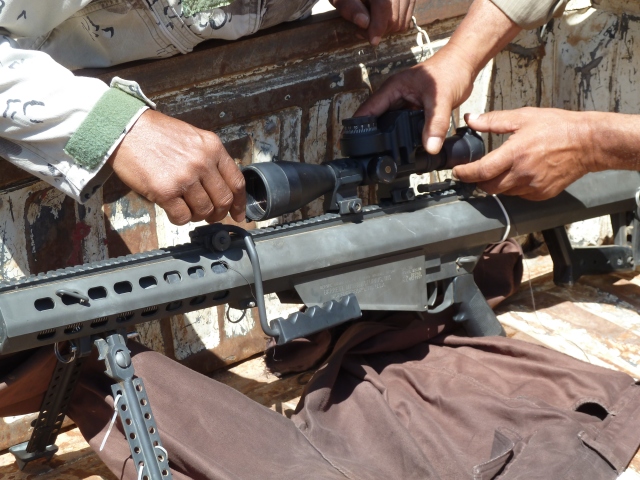Whilst work continues on the Small Arms and Light Weapons (SALW) database that I am currently compiling, I continue to come across a few interesting optics here and there. You can see my first two posts on these here, and here. I’ve added a handful more below.
This Barrett M82A1M is fitted with a Leupold 4.5–14×50 Mark 4 telescopic rifle scope. It also features the Barrett Optical Ranging System, or BORS. This device is an integrated ballistic computer, that couples directly to the elevation knob on the Leupold scope. It compensates for temperature, barometric pressure, and changes in the position of the rifle (tilt and cant).
Picture courtesy of James Bays (Al Jazeera)
A number of FN P90 submachine guns have cropped up in Libya, as part of an FN-Libya arms deal in 2009/10. They are fitted with Ring Sights MC-10-80 reflex sights. The NVD-compatible sight features a black ‘daytime’ reticule, and a red ‘T’ shape, lit by a Gaseous Tritium Light Source (GTLS), for night use.
Photo courtesy of Bradley E. Owens (Osprey Security Services).
This is a 9P135M-1 launcher for the 9M111 Fagot (AT-4 Spigot) and 9M113 Konkurs (AT-5 Spandrel) series of missiles. So far I’ve only seen 9M111M Faktoriya /Fagot-M (AT-4C Spigot C) missiles in photos from Libya. You can see the 9S451 guidance box in the background, and the 9Sh119 10x optical sight in the foreground. The launcher operates on the Semi-Automatic Command to Line of Sight (SACLOS) guidance principle.
Photo courtesy of Peter Bouckaert (Human Rights Watch)
This photo shows an AK-103-2 (you can read about their appearance in Libya here) fitted with a North Korean copy of the PGO-7 series optical sights, originally intended for use on the RPG-7. You can see some Chosŏn’gŭl – the DPRK term for Hangeul script – characters clearly in this photograph. This is the first photo I’ve seen of such a sight, so any information would be appreciated. You can contact me here.
Photo courtesy of Damien Spleeters (The Trigger).





I think it’s 련결 (연결 in SK grammar change) which means connect or in this case on and on the bottom it says 차단 (which means to prevent/block/stop) or off in this case. SK uses the to words differently but considering that it is a switch I think we can reasonably assume what it means.
Many thanks for that, tae!